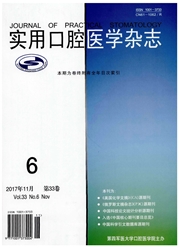

 中文摘要:
中文摘要:
目的:比较正常与炎症来源牙周膜干细胞(H-PDLSCs与P-PDLSCs)中乙酰基转移酶MORF表达水平的差异及其对PDLSCs分化的调控。方法:有限稀释法培养H-PDLSCs与P-PDLSCs,LPS、TNF-α、IL-β及三者混合物体外模拟炎症微环境诱导H-PDLSCs(IP-PDLSCs);基因与蛋白检测方法对比2种来源PDLSCs中MORF的表达水平;蛋白检测方法检测IPPDLSCs中MORF的表达水平;基因、蛋白检测与茜素红染色方法对比H-PDLSCs及下调MORF基因后的PDLSCs成骨基因表达的差异。结果:与H-PDLSCs相比,P-PDLSCs中MORF的表达显著下降(P〈0.05);IP-PDLSCs中MORF的表达下降;MORF基因被下调后,PDLSCs成骨能力下降(P〈0.05)。结论:牙周炎及炎症微环境会导致PDLSCs中MORF表达的下降,从而使其成骨分化受到抑制。
 英文摘要:
英文摘要:
Objective: To compare acetyltransferase MORF level in periodontal ligament stem cells(PDLSCs) derived from healthy individuals (H-PDLSCs) with those derived from the individuals with periodontitis (P-PDLSCs). And to determine the effect of MORF on the osteogenic differentiation potential of PDLSCs. Methods: Human H-PDLSCs and P-PDLSCs were cultured and cloned with limited dilution method. H-PDLSCs were stimulated by LPS, TNF-or, IL-13 and the mix of the 3 inflammatory factors to imitate inflammatory environment(IP-PDLSCs). Quantitative RT-PCR and Western Blot were applied to examine different expression of MORF in H-PDLSCs and P-PDLSCs. Western Blot was applied to detect expression of MORF in IP-PDLSCs. Quantitative RT-PCR, Western Blot and alizarin red staining were applied to determine osteogenie differentiation potential of H-PDLSCs with MORF knock- down. Results: Quantitative RT-PCR and Western Blot showed lower expression of MORF in P-PDLSCs compared with H-PDLSCs (P 〈0.05). Western Blot revealed lower expression of MORF in IP-PDLSCs. Quantitative RT-PCR, Western Blot and alizarin red stai- ning indicated osteogenie differentiation potential was inhibited in H-PDLSCs with MORF knockdown( P 〈 0.05 ). Conclusion: Peri- odontitis can suppress the expression of MORF in PDLSCs and inhibite the osteogenic differentiation potential of PDLSCs.
 同期刊论文项目
同期刊论文项目
 同项目期刊论文
同项目期刊论文
 期刊信息
期刊信息
